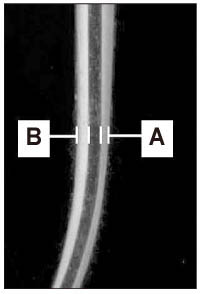References
1. Garip Y, Gunday M. The use of computed tomography when comparing nickel-titanium and stainless steel files during preparation of simulated curved canals. Int Endod J 2001. 34(6)452–457.
2. Baumann MA, Roth A. Effect of experience on quality of canal preparation with rotary nickel-titanium files. Oral Surg Oral Med Oral Pathol Oral Radiol Endod 1999. 88(6)714–718.
3. Schafer E, Schulz-Bongert U, Tulus G. Comparison of hand stainless steel and nickel titanium rotary instrumentation: a clinical study. J Endod 2004. 30(6)432–435.
4. Peters OA. Current Challenges and Concepts in the Preparation of Root Canal Systems: A Review. J Endod 2004. 30(8)559–567.
5. Bergmans L, Van Cleynenbreugel J, Beullens M, Wevers M, Van Meerbeek B, Lambrechts P. Progressive versus constant tapered shaft design using NiTi rotary instruments. Int Endod J 2003. 36(4)288–295.
6. Clauder T, Baumann MA. ProTaper NT system. Dent Clin North Am 2004. 48(1)87–111.
7. Schafer E. Shaping ability of Hero 642 rotary nickel-titanium instruments and stainless steel hand K-Flexofiles in simulated curved root canals. Oral Surg Oral Med Oral Pathol Oral Radiol Endod 2001. 92(2)215–220.
8. Hata G, Uemura M, Kato AS, Imura N, Novo NF, Toda T. A comparison of shaping ability using ProFile, GT file, and Flex-R endodontic instruments in simulated canals. J Endod 2002. 28(4)316–321.
9. Ankrum MT, Hartwell GR, Truitt JE. K3 Endo, ProTaper, and ProFile systems: breakage and distortion in severely curved roots of molars. J Endod 2004. 30(4)234–237.
10. Park WK, Lee HJ, Hur B. Shaping ability of nickel-titaniumrotary files. J Korean Acad Conserv Dent 2004. 29(1)44–50.
11. Qualtrough AJ, Dummer PM. Undergraduate endodontic teaching in the United Kingdom: an update. Int Endod J 1997. 30(4)234–239.
12. Qualtrough AJ, Whitworth JM, Dummer PM. Preclinical endodontology: an international comparison. Int Endod J 1999. 32(5)406–414.
13. Sonntag D, Guntermann A, Kim SK, Stachniss V. Root canal shaping with manual stainless steel files and rotary Ni-Ti files performed by students. Int Endod J 2003. 36(4)246–255.
14. Sonntag D, Delschen S, Stachniww V. Root-canal shaping with manual and rotary Ni-Ti files performed by students. Int Endod J 2003. 36(11)715–723.
15. Hanni S, Schonenberger K, Peters OA, Barbakow F. Teaching an engine-driven preparation technique to undergraduates: initial observations. Int Endod J 2003. 36(7)476–482.
16. Calhoun G, Montgomery S. The effects of four instrumentation techniques on root canal shape. J Endod 1988. 14(6)273–277.
17. Kosa DA, Marshall G, Baumgartner JC. An analysis of canal centering using mechanical instrumentation techniques. J Endod 1999. 25(6)441–445.
18. Parashos P, Messer HH. Questionnaire survey on the use of rotary nickel-titanium endodontic instruments by Australian dentists. Int Endod J 2004. 37(4)249–259.
19. Yared G, Bou Dagher F, Kulkarni K. Influence of torque control motors and the operator's proficiency on ProTaper failures. Oral Surg Oral Med Oral Pathol Oral Radiol Endod 2003. 96(2)229–233.
20. Yared GM, Kulkarni GK. Failure of ProFile Ni-Ti instruments used by an inexperienced operator under access limitations. Int Endod J 2002. 35536–541.
21. Gambarini G. Cyclic fatigue of ProFile rotary instruments after prolonged clinical use. Int Endod J 2001. 34386–389.
22. Szep S, Gerhardt T, Leitzbach C, Luder W, Heidemann D. Preparation of severely curved simulated root canals using engine-driven rotary and conventional hand instruments. Clin Oral Investig 2001. 5(1)17–25.
23. Yared GM, Dagher FE, Machtou P, Kulkarni GK. Influence of rotational speed, torque and operator proficiency on failure of Greater Taper files. Int Endod J 2002. 35(1)7–12.
24. Yared GM, Bou dagher FE, Machtou P. Cyclic fatigue of ProFile rotary instruments after clinical use. Int Endod J 2000. 33204–207.
25. Park SH, Cho KM, Kim JW. The Efficiency of the Ni-Ti Rotary files in Curved Simulated Canals Shaped by Novice Operators. J Korean Acad Conserv Dent 2003. 28(2)146–155.
26. Yun HH, Kim SK. A comparison of the shaping abilities of 4 nickel-titanium rotary instruments in simulated root canals. Oral Surg Oral Med Oral Pathol Oral Radiol Endod 2003. 95(2)228–233.
27. Schafer E, Vlassis M. Comparative investigation of two rotary nickel-titanium instruments: ProTaper versus RaCe. Part 1. Shaping ability in simulated curved canals. Int Endod J 2004. 37(4)229–238.
28. Ko HJ, Baek SH. A study of histomorphological change of curved root canal preparation using GT rotary file, profile and stainless steel K-file. J Korean Acad Conserv Dent 2002. 27(6)612–618.
29. Dobo-Nagy C, Serban T, Szabo J, Nagy G, Madlena M. A comparison of the shaping characteristics of two nickel-titanium endodontic hand instruments. Int Endod J 2002. 35283–288.
30. Song YL, Bian Z, Fan B, Fan MW, Gutmann JL, Peng B. A comparison of instrument-centering ability within the root canal for three contemporary instrumentation techniques. Int Endod J 2004. 37265–271.
31. Kim HC, Park JK, Hur B. Relative efficacy of three Ni-Ti file systems used by undergraduates. J Korean Acad Conserv Dent 2005. 30(1)38–48.
32. Berutti E, Chiandussi G, Gaviglio I, Ibba A. Comparative analysis of torsional and bending stresses in two mathematical models of nickel-titanium rotary instruments: ProTaper versus ProFile. J Endod 2003. 29(1)15–19.







